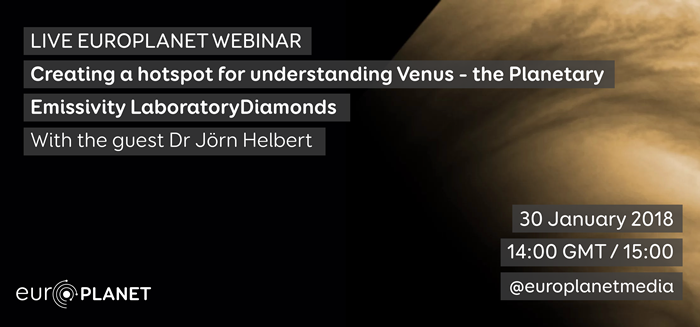What are the challenges and solutions for simulating Venus and what measurements using the Planetary Spectroscopy Laboratory facility will enable scientists to find out about the surface of Earth’s extraordinary twin planet? Join on 30 January 2018, 14:00 GMT / 15:00 CET: “Creating a hotspot for understanding Venus – the Planetary Emissivity Laboratory” with Dr Jörn Helbert. Register and send your questions https://goo.gl/forms/zcE7muAVoxEHk4Vo1

Although Venus is a similar size to Earth and sometimes called its twin planet, it’s a very different place. Venus is surrounded by a thick atmosphere of mainly carbon dioxide and clouds of sulphuric acid that make it very difficult to study the planet’s surface. Until recently, it was thought that a lander was needed to analyse the chemical composition of rocks on the ground. But with surface temperatures averaging 462 degrees Celsius – twice as hot as most household ovens – and pressures equivalent to nearly a kilometre’s depth in Earth’s oceans, landing on Venus is a huge challenge. No spacecraft has touched down on the surface since the Soviet Union’s Vega probes in 1985.
In recent years, planetary scientists have taken advantage of “spectral windows” in Venus’s atmosphere that are transparent to certain wavelengths of infrared light. Observations using Venus Express’s Venus Monitoring Camera (VMC) and Visible and Infrared Thermal Imaging Spectrometer (VIRTIS) instruments have revealed chemical variations that can be related to geological features on the surface of Venus.
Because different chemical compounds emit radiation at specific electromagnetic wavelengths, every mineral has a unique “spectral fingerprint” of emission lines. This means that, to interpret their observations and work out which rocks are present, planetary scientists need reference catalogues showing these fingerprints acquired under conditions matching those on the surfaces being studied.
For more than 40 years, planetary scientists have been attempting to create these libraries. Now, Dr Jörn Helbert and colleagues have come up with an effective solution. The Planetary Spectroscopy Laboratory (PSL) at the Deutschen Zentrums für Luft- und Raumfahrt (DLR) is a facility able to carry out routine analysis of Venus analogue materials over the whole range of Venus surface temperatures and at the key wavelengths for the transparent spectral windows in Venus’s atmosphere.
